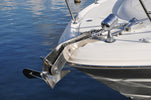
Anchor Away: A Comprehensive Guide to Safely Anchoring Your Boat
, by Safe Water Team, 4 min reading time

, by Safe Water Team, 4 min reading time
Anchoring your boat is a fundamental skill that every boater should master. Whether you're stopping for a leisurely swim, enjoying a picnic on the water, or spending the night at anchor, knowing how to safely anchor your boat is essential for enjoying your time on the water with peace of mind. In this guide, we'll walk you through the step-by-step process of anchoring your boat safely and securely.
Before you can safely anchor your boat, you need to select the right anchor for your vessel and the prevailing conditions. Consider factors such as the size and weight of your boat, the type of bottom (e.g., sand, mud, rock), and the expected wind and current conditions. Popular types of anchors include plow, fluke (Danforth), and grapnel anchors, each with its own strengths and weaknesses.
Selecting the Anchorage: Choose a suitable location to anchor based on water depth, bottom conditions, protection from wind and waves, and proximity to hazards such as shoals, rocks, or other vessels. Consult nautical charts, guidebooks, and local knowledge to identify safe anchorage areas in your boating area.
Approaching the Anchorage: Approach the chosen anchorage area at a slow, controlled speed, taking care to avoid disturbing nearby boats, swimmers, or wildlife. Use navigational aids such as GPS, depth sounder, and visual landmarks to guide your approach and ensure you're anchoring in the desired location.
Preparing the Anchor and Rode: Prepare the anchor and rode (anchor line or chain) for deployment by securing the bitter end of the rode to a strong point on the boat, such as a cleat or bow eye. Ensure the anchor is properly stowed and ready for deployment, with any shackles or connections securely fastened.
Deploying the Anchor: Slowly motor or drift over the desired anchorage location while paying out the rode gradually to allow the anchor to set properly. Release the anchor by lowering it over the bow or transom, taking care to avoid tangling or fouling the rode.
Setting the Anchor: Allow the boat to drift back with the wind or current while paying out additional rode until the desired scope (ratio of rode length to water depth) is achieved. For most conditions, a scope of 5:1 to 7:1 is recommended to ensure proper holding power. Once the desired scope is reached, secure the rode to the anchor cleat and allow the boat to settle back gently until the anchor digs into the bottom and holds firm.
Testing the Anchor: After setting the anchor, put the engine in reverse at idle speed to test the anchor's holding power and ensure it is properly set. If the boat holds position and the rode remains taut, the anchor is secure. If not, you may need to reset the anchor or choose a different anchorage location.
Monitoring Conditions: Once anchored, monitor weather and tide conditions regularly to ensure the anchor continues to hold securely. Be prepared to adjust your position or retrieve the anchor if conditions deteriorate or if you encounter dragging.
Anchoring your boat safely and securely is a skill that every boater should master to enjoy their time on the water with confidence and peace of mind. By following the step-by-step process outlined in this guide and adhering to safety tips and best practices, you can anchor your boat effectively in a variety of conditions and enjoy worry-free boating adventures on the water. So next time you drop anchor, do so with confidence, knowing that you've anchored safely and securely for a day of fun on the water.